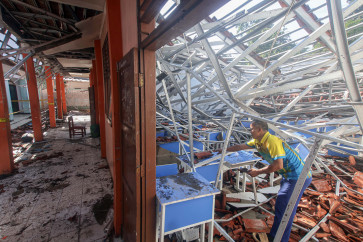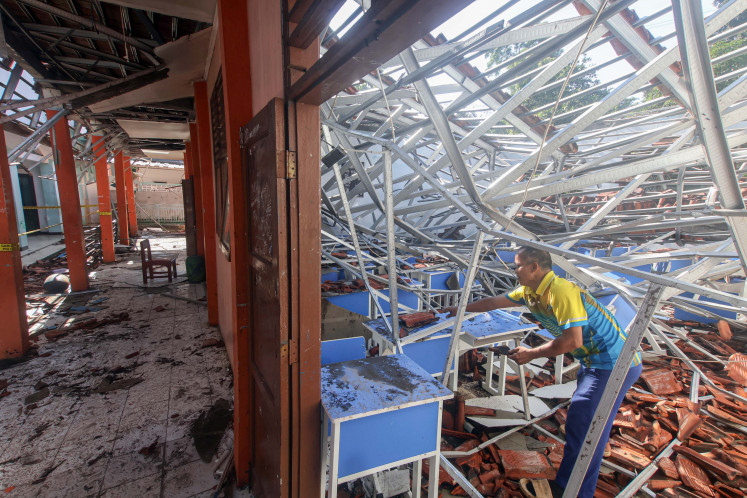Popular Reads
Top Results
Can't find what you're looking for?
View all search resultsPopular Reads
Top Results
Can't find what you're looking for?
View all search resultsDilemma of energy used for cooking in Indonesia
Indonesia still relies on imports to cope with a shortage of liquefied petroleum gas (LPG), which is expected to worsen in the coming years because of surging demand
Change text size
Gift Premium Articles
to Anyone
I
ndonesia still relies on imports to cope with a shortage of liquefied petroleum gas (LPG), which is expected to worsen in the coming years because of surging demand.
Indonesia’s consumption of LPG rose to 6.67 million metric tons last year, up 1.5 percent from 2015, according to the data from the Energy and Mineral Resources Ministry. The domestic production of LPG, however, dropped to 2.24 million metric tons in 2016 from 2.27 million the previous year. This has led to an increase in LPG imports to 4.42 million metric tons in 2016 from 4.3 million in 2015.
This LPG shortage was rooted in a massive energy program launched by the government in 2007 to switch from kerosene to LPG as cooking fuels. Meanwhile, the Central Statistics Agency (BPS) recorded that 24.8 million households still rely on firewood for cooking.
Analysis of the LPG program found that the program mostly benefited higher and medium income households in suburban areas. In fact, it doesn’t significantly lower the average number of energy-poor people in rural areas. This situation has become a driving force for those people to continue using wood as a cooking fuel.
Actually, the number of LPG users increases and of kerosene users declines, yet the number of firewood users remains the same and even increases. Some people who already have access to LPG still like to use firewood because they believe food tastes better when cooked over a wood fire. The firewood cooking has been a cultural tradition and a social practice for rural people. Even on a business level, the firewood tradition matters. A tofu company in East Java maintains the use of wooden and stone devices, as well as firewood.
Consequently, the practice adversely impacts local forest ecosystems and contributes to a rise in deforestation, which is estimated to reach 2.5 million hectares per year. One of the direct causes is humans taking firewood for cooking from surrounding forests. The firewood cooking also causes indoor air pollution and a negative impact on respiratory health. It generates a high amount of airborne particulate matter and black carbon concentrations when the firewood is burned in a room with poorly ventilated furnaces and cookstoves.
To respond to the problem, Hivos-International NGO and SNV (the Netherlands Development Organization) established a program in Indonesia called BIRU (biogas for households) to change the behavior of rural people. The program installed 16,015 digesters in nine provinces in Indonesia from 2010 to 2016.
The government provided grant to the program so the rural people would be able to use the biogas for free. Biogas is categorized as a clean renewable energy derived from second generation biofuels. The feedstock needed to produce biogas is plentiful in Indonesia and most existing biogas is made using farm manure and slurries in rural areas. Biogas also has many different end uses, such as cogeneration to produce electricity and heat, to power lights and to drive vehicles.
The government has several biogas programs run by different ministries, which are mostly connected with BIRU. In those biogas programs, the government used to hire YRE as an Indonesian NGO and Hivos as implementing partner. Hivos and YRE also worked with a certified construction partner organization to install the biogas digesters.
Aside from the work with the government, Hivos and YRE are also working on specific projects based on grants and loans. Biogas used in a decentralized energy system seems to be a solution for remote rural areas. This technology is expected to become a new social practice of rural people.
Nevertheless, in practice, the biogas system has still not been widely developed for households all over Indonesia. This is one of the reasons why the number of firewood users is still high. Challenges are found in the schemes of the program and technology issues.
Dissemination of the program is limited by government funding and program mechanisms. Credit schemes devised by the NGO do not work well because of the financial conditions of the rural people.
Based on a social practice approach, the government should change the system of biogas provision, such as by shifting from a grant mechanism to be subsidy model so the budget can be utilized to provide more digesters in rural areas.
The government can use evaluations from commercial schemes established by YRE as benchmarks for the subsidy model. This schemes will bring opportunities for private entities to take part in the sector. At the same time, this will also change the mentality of the users toward their own digesters. The government also should avoid mismanagement in screening who is eligible for the subsidy, so that the funds allocated for the improvement of biogas are spent effectively and efficiently.
A second issue is dealing with the technology challenge. Most farmers still find difficulties in operating and maintaining the digesters because of a lack of knowledge. However, there are still opportunities to fix this issue when the biogas budgets are used efficiently. The budgets can be utilized for the training of rural people to prepare them to be independent in managing their own biogas.
Proper training is required. The program has to make sure all users attend the training and understand the content of the training through hands-on practice. If proper schemes through subsidies are successful, they should be completed with detailed terms about training procedures. Then the schemes can lead to integrated solutions for better program implementation, training programs and quality of biogas and users. In the end, biogas can be an alternative answer for the dilemma to reduce dependency on LPG imports and avoid environmental impacts from the use of firewood for cooking.
____________________________________
The writer is associate researcher in Sustainability-Resilience Co. and a Master’s degree candidate in environmental sciences at Wageningen University in the Netherlands.










